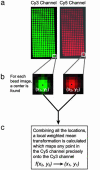Single molecule high-resolution colocalization of Cy3 and Cy5 attached to macromolecules measures intramolecular distances through time
- PMID: 15668396
- PMCID: PMC545495
- DOI: 10.1073/pnas.0409487102
Single molecule high-resolution colocalization of Cy3 and Cy5 attached to macromolecules measures intramolecular distances through time
Abstract
Here we present a technique called single-molecule high-resolution colocalization (SHREC) of fluorescent dyes that allows the measurement of interfluorophore distances in macromolecules and macromolecular complexes with better than 10-nm resolution. By using two chromatically differing fluorescent molecules as probes, we are able to circumvent the Rayleigh criterion and measure distances much smaller than 250 nm. The probes are imaged separately and localized individually with high precision. The registration between the two imaging channels is measured by using fiduciary markers, and the centers of the two probes are mapped onto the same space. Multiple measurements can be made before the fluorophores photobleach, allowing intramolecular and intermolecular distances to be tracked through time. This technique's lower resolution limit lies at the upper resolution limit of single molecule FRET (smFRET) microscopy. The instrumentation and fluorophores used for SHREC can also be used for smFRET, allowing the two types of measurements to be made interchangeably, covering a wide range of interfluorophore distances. A dual-labeled duplex DNA molecule (30 bp) was used as a 10-nm molecular ruler to confirm the validity of the method. We also used SHREC to study the motion of myosin V. We directly observed myosin V's alternating heads while it walked hand-over-hand along an actin filament.
Figures




References
-
- Weiss, S. (1999) Science 283, 1676-1683. - PubMed
-
- Blanchard, S. C., Gonzalez, R. L., Kim, H. D., Chu, S. & Puglisi, J. D. (2004) Nat. Struct. Mol. Biol. 11, 1008-1014. - PubMed
-
- Zhuang, X., Bartley, L. E., Babcock, H. P., Russell, R., Ha, T., Hershlag, D., Chu, S. (2000) Science 288, 2048-2051. - PubMed
Publication types
MeSH terms
Substances
Grants and funding
LinkOut - more resources
Full Text Sources
Other Literature Sources

